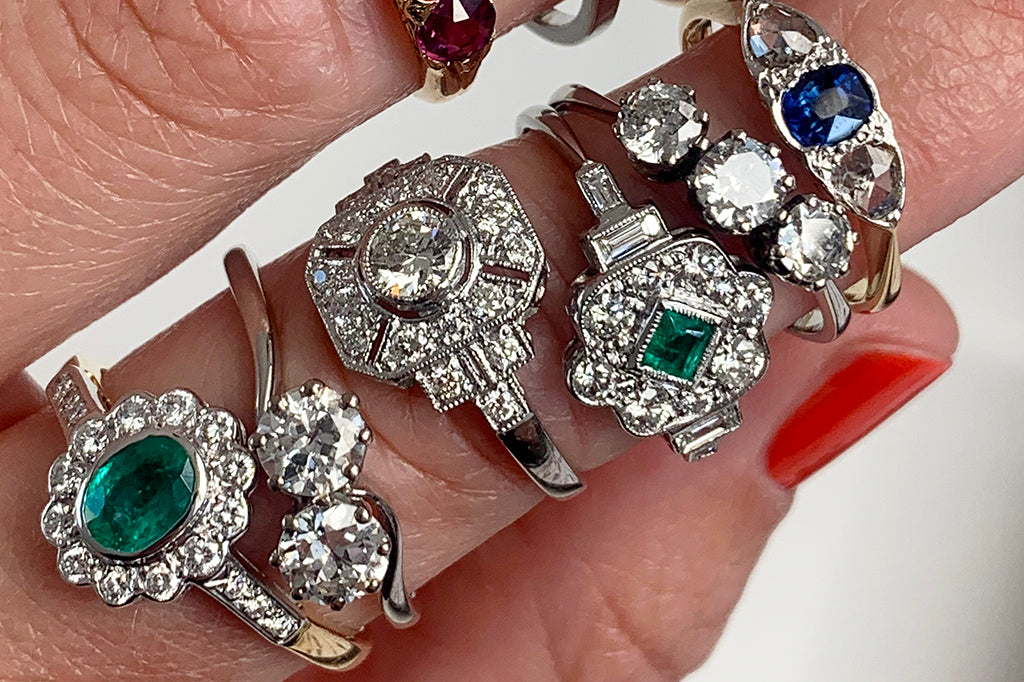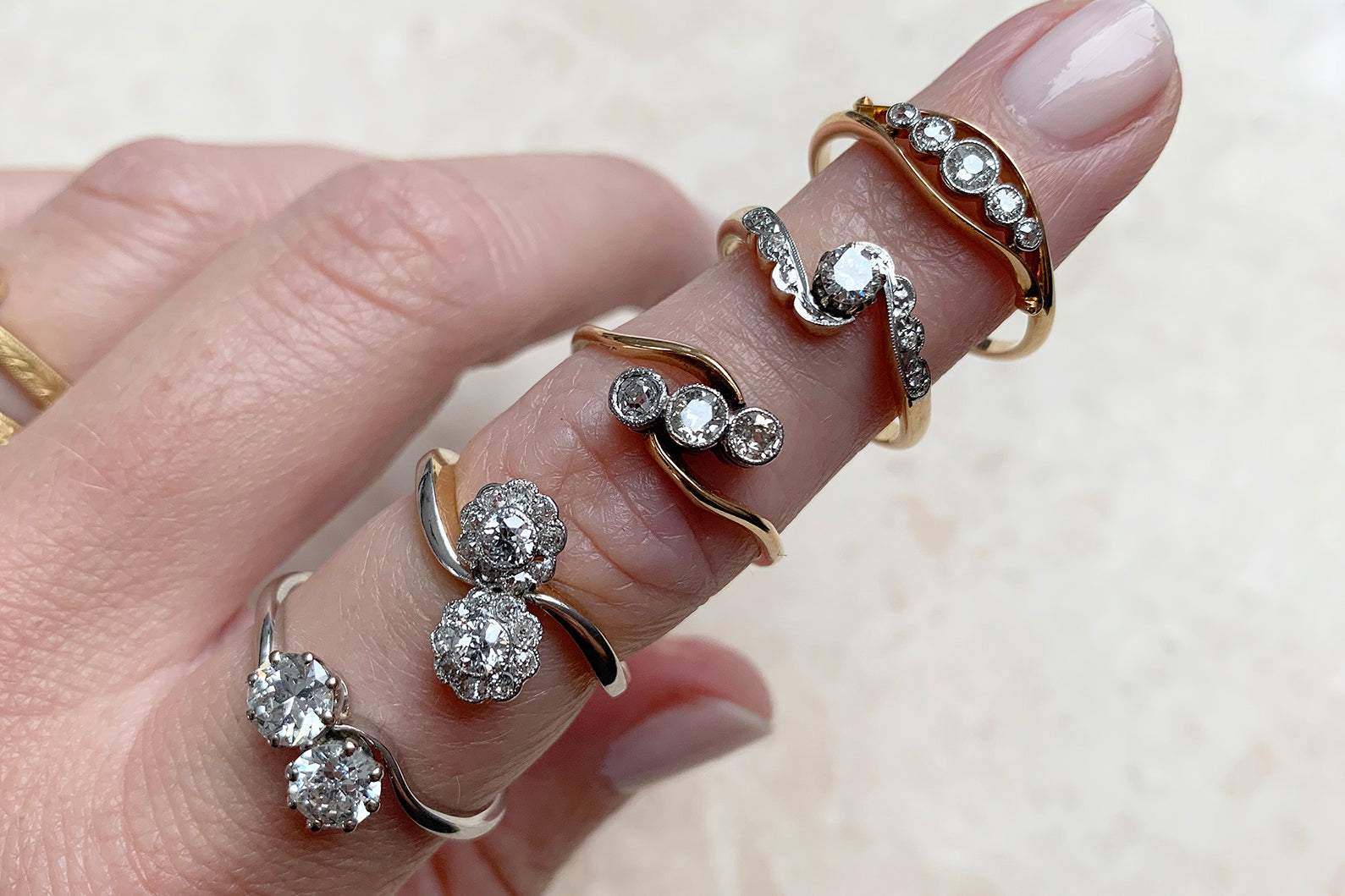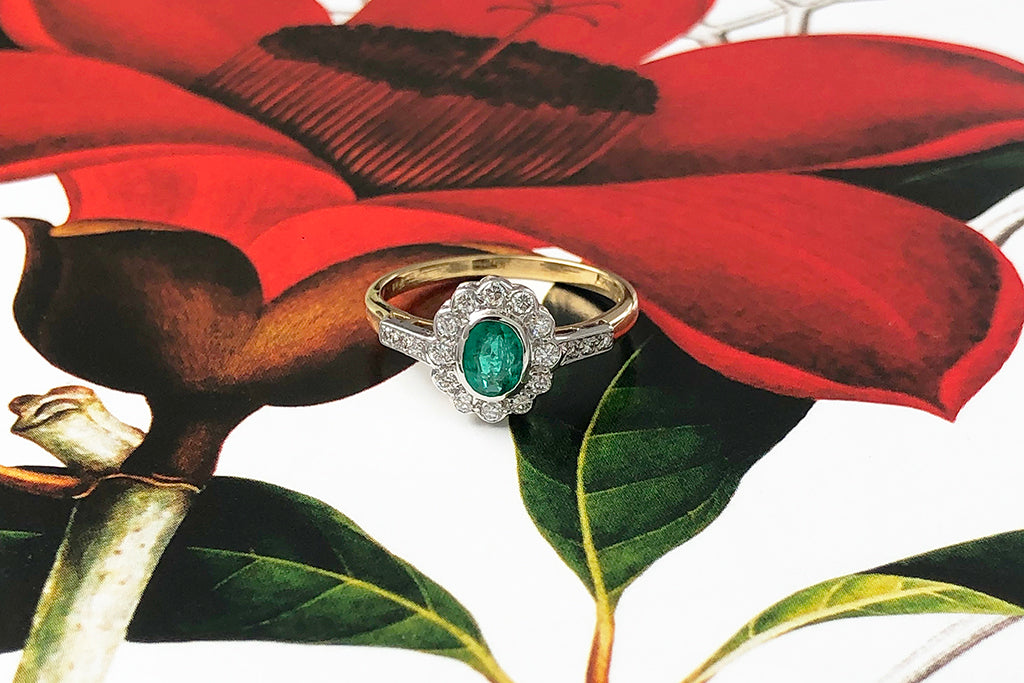
What's the best gemstone setting for a vintage engagement ring?
Engagement rings have come a long way since the Ancient Romans asked for their sweethearts’ hands in marriage using bulky iron bands, with advances in manufacturing technology and the ever-dynamic ebb and flow of trends offering up a number of distinct styles over the years. For many engagement ring shoppers, this wealth of choice may initially feel overwhelming. To relieve you of some of that puzzlement, today we’re exploring the most common styles of engagement ring setting, weighing up the pros and cons of each.
WHAT IS A SETTING?

A stone setting is the way in which a diamond or gemstone is secured into a piece of jewellery. The design of a setting not only determines how it holds the stone in place, but affects its overall protection, its interaction with light, and the structure and appearance of the jewel itself.
STYLE 1: THE BEZEL SETTING

The bezel setting – or rub-over setting - envelops the stone in a bed of precious metal which is subsequently folded all the way around to lock it firmly into place. When complete, the stone is encircled by a rim of metal with only its table visible, creating a streamlined profile.
Simple but highly effective and secure, the concept of the bezel setting can be traced back to ancient civilisations like Egypt and Mesopotamia and has endured various epochs of fashion and design since, needing to evolve very little. Continuing to hold its own in the modern-day context, it’s a timeless and versatile setting style with a rich heritage. Examples can be found in vintage engagement rings throughout the ages, from our Edwardian Vivienne ring to Sylvie and Charlotte of the early 20th century and Jean, our modern vintage homage to the Art Deco era.
PROS: The bezel setting’s enduring appeal lies in its ability to hold a firm grip on its stone, providing excellent protection from snags or knocks across a substantial surface area. Its seamless integration of a gemstone into a piece of jewellery makes it the perfect choice for anyone who leads an active lifestyle or simply feels a little nervous about wearing delicate jewellery on a day-to-day basis. What’s more, the bezel setting has proven itself as a firm withstander of trends, promising an engagement ring that will age gracefully over the years.
CONS: The bezel setting doesn’t expose as much of the stone as more open settings styles do, enabling light to enter and leave only from the top. If you dream of an engagement ring that sparkles enthusiastically, the bezel setting is perhaps a little too enclosed for you. What’s more, bezel settings often sit low against the ring’s band, creating an invasive contour that can sometimes inhibit a wedding band’s ability to sit perfectly flush in the future. This isn’t the end of the world, however – you may just choose a shaped wedding band to close the small space between the two rings, or not worry about the gap at all.
STYLE 2: THE CLAW SETTING

In 1886, Tiffany & Co. debuted their revolutionary Tiffany® Setting ring. A slim platinum band set with a single diamond, this was the first design ever to elevate the stone from the finger, enhancing its natural radiance by allowing light to enter and leave at every angle. Celebrated in film, art and literature, the six-claw Tiffany® Setting quickly became the face of the engagement ring as we know it.
This classic setting – also known as the solitaire when just one diamond or gemstone is present - is characterised by metal prongs; usually 4-6, depending on the shape and size of the central stone. Designed to thrust your gem into the spotlight, it’s often selected for those who favour sparkle, radiance and old-school romance.
Bernadette, Irene and Evelyn demonstrate how claw settings are used to create an impactful impression on the finger, and how claws themselves can take on a number of different forms, such as talon claws and crown claws.
PROS: Timeless and classic, the claw setting can possess serious ‘Wow!’ factor, celebrating a gemstone’s natural beauty in a way that no other setting can. What’s more, a raised setting often enables a future wedding band to sit perfectly flush to its neighbouring engagement ring with ease.
CONS: By the delicate nature of the claw setting, it must be treated with the utmost care. Not only does a raised setting leave your central stone exposed and somewhat vulnerable, the setting itself is ultimately comprised of nothing but very thin strands of metal. If a foreign body lodges itself under a claw (think clothing, hair or shower loofahs!), the prong is easily bent – enough, sometimes, to loosen the stone. The same goes for light bumps to the ring. Although all of our vintage and antique engagement rings go through a rigorous process of checking, cleaning, polishing and, where necessary, repairing – ensuring that each is sold in its best possible condition – no piece of jewellery is invincible. That’s why we recommend never wearing a claw-setting engagement ring whilst showering, playing sports or carrying out any form of manual labour with the hands.
To learn more about some of the most common issues with vintage engagement rings and how they can be addressed, check out this blog post.
STYLE 3: THE CLUSTER SETTING

A cluster is a busy arrangement of gemstones, set close to one another for maximum sparkle and surface area. Creating an amplified visual impression, the cluster setting was designed as an opportunity for the couple on a modest budget to attain the highest possible carat weight and most impressive possible finish.
Highly versatile, the cluster blueprint has ushered in many a variation over the years, each encapsulating the trends of the time. Whilst flower-inspired clusters like our Martha, Anna and Darcy rings were typical of the Victorian and Edwardian eras, precise halo settings like our Ophelia and Estelle designs enjoyed their heyday throughout the 20th century.
PRO: Cluster settings often create the clever illusion of a larger central stone. Choosing a nimbus of halo of sparkling diamonds is a crafty means of attaining pizzazz without the price tag of a high-carat centrepiece.
CONS: Cluster settings are often bulky and low-lying, covering a large surface area on the finger and making it tricky to find a wedding band in the future that will sit perfectly flush against it.


